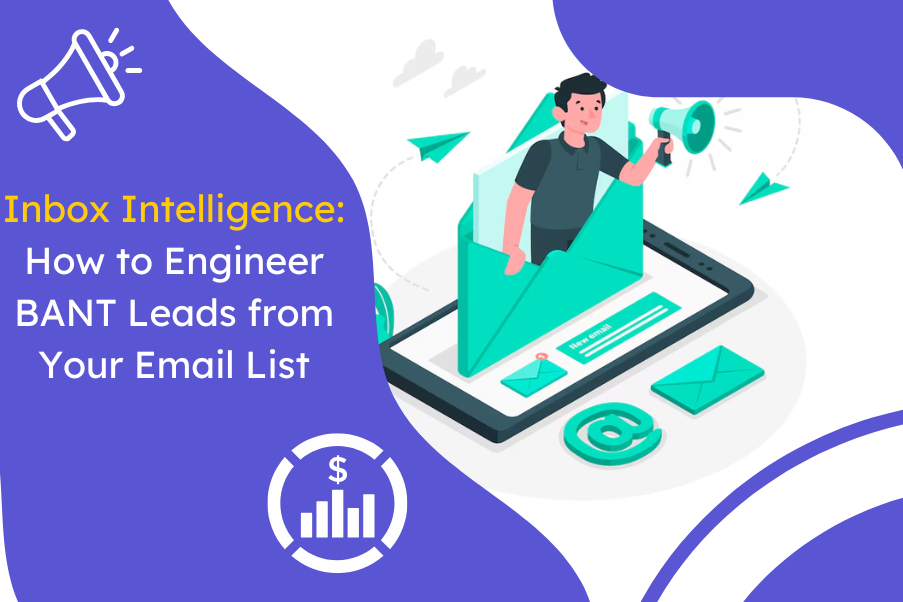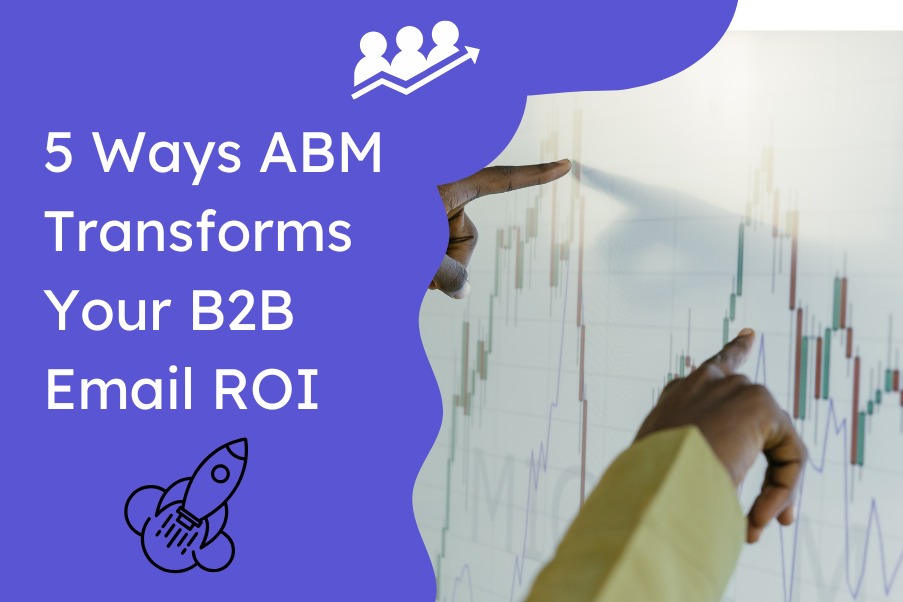Inbox Intelligence: How to Engineer BANT Leads from Your Email List
In a B2B landscape where decision cycles are long and inboxes are crowded, email can feel like a blunt instrument. But when wielded strategically, it’s anything but. Today’s smartest marketers are transforming their email lists from static repositories into active intelligence hubs using behavioral insights, smart segmentation, and automated scoring to surface leads that are not just interested, but ready to buy.
This is where Inbox Intelligence meets the BANT leads from email framework. Instead of spraying and praying with mass campaigns, you can now engineer sales-ready leads by decoding subtle cues hidden in everyday email interactions.
In this guide, we’ll show you how to tap into your email list to qualify BANT leads from email with surgical precision so you stop wasting time on cold prospects and start winning faster.
What Are BANT Leads and Why Do They Matter?
The BANT leads from email framework standing for Budget, Authority, Need, and Timeline. It was developed by IBM as a streamlined approach to lead qualification. It helps businesses determine whether a prospect is worth pursuing by evaluating four key criteria: whether the lead has the budget to afford the solution, holds the authority to make purchasing decisions, has a real need that the product or service can address, and is operating within a relevant purchase timeline. By applying BANT to your email list, you can identify leads who are both interested and capable of buying, allowing your marketing and sales teams to focus their efforts more efficiently and avoid wasting time on unqualified prospects.
Why Email Lists Are Ideal for BANT Qualification
Your email list is more than a communication channel, it’s a powerful, insight-driven tool for lead qualification. Every interaction whether it’s an email open, a link click, a form submission, or a reply offers behavioral signals. These signals help you understand how engaged a contact is and what stage they’re at in the buying journey.
Here’s why email is the ideal medium for applying the BANT framework:
- It’s permission-based: Subscribers have already opted in, showing an initial level of interest and trust. That’s a great starting point for qualification.
- Behavior maps directly to BANT signals: For instance, clicking on a pricing link could indicate Budget readiness, while engaging with content about solutions points to a clear Need. Opening decision-maker guides might hint at Authority, and downloading buyer checklists could signal a buying Timeline.
- Progressive insight gathering: You don’t need to know everything at once. Email campaigns allow you to collect more data gradually—without overwhelming or annoying your audience.
- Email segmentation tips and automation at scale: With smart segmentation and automation tools, you can tailor email journeys to ask the right questions at the right time nudging leads further along the BANT path without sounding pushy.
B2B inbox engagement makes it possible to turn raw email engagement into actionable qualification insights, helping you surface high-potential leads before your competitors do.
Smart Email Strategies to Engineer BANT Leads
To generate high-quality BANT leads from email, you need more than a list of contacts, you need smart, behavior-driven strategies that will align with each stage of the buyer’s journey. Below are four actionable strategies designed specifically for B2B companies to transform their email campaigns into a BANT-qualified lead generation engine.
Segment Your List Strategically
The first step to an effective lead qualification strategy is segmentation. By breaking down your email list into specific groups based on key attributes, you can tailor your outreach to address the unique needs, behaviors, and intent of each segment. Segmentation based on company size or industry helps you identify budget and need; for example, larger companies may have bigger budgets and more complex requirements. Understanding a lead’s job title or role is key to identifying authority like executives, managers, and decision-makers are more likely to play a role in the purchase process. Additionally, engagement history helps uncover need and timelin. If a lead engages frequently with emails about product demos or pricing, they might be close to making a decision. Using email segmentation tips enables you to tailor your messaging to align with the right BANT signals, ensuring your outreach reaches the right people at the right time.
Craft Content That Uncovers BANT Signals
Content plays a crucial role in uncovering where a lead stands in the buying journey. By crafting emails designed to address specific BANT criteria, you can gather valuable insights into a lead’s readiness to buy. For example, budget can be inferred when a lead clicks on pricing information or uses an ROI calculator. Authority can be gauged through gated content forms that ask for details about the lead’s role in the decision-making process. To identify need, share case studies, success stories, or pain-point-driven emails that highlight how your solution solves common challenges. Timeline can be uncovered by offering time-sensitive offers or prompting leads to share their expected purchase timelines through surveys or follow-up emails. By creating content tailored to each BANT element, you gain insights into each lead’s position without the need for direct sales calls.
Use Intelligent Lead Scoring
Intelligent lead scoring is a game-changer when it comes to prioritizing your outreach. By assigning point values to various engagement actions such as opening emails, clicking product links, downloading resources, or filling out forms. You can create a clear picture of each lead’s interest level. Leads that consistently engage with your content, especially around BANT-specific areas like pricing or product demos, are scored higher and flagged as more qualified. As leads accumulate points, once they hit a certain threshold, automated workflows can trigger next steps like moving them to the sales team for direct engagement or placing them in a more advanced nurture campaign. This intelligent scoring mechanism helps your sales team focus their efforts on leads that are genuinely interested and close to making a purchase, making the entire process more efficient and targeted.
Nurture and Qualify with Progressive Profiling
To avoid overwhelming your leads with too many questions upfront, use progressive profiling to gradually build a detailed BANT profile over time. Instead of asking for all the information in a single form, break it up across multiple interactions. For example, in the first form, you can ask for basic details like name and job title, which helps determine authority. In subsequent forms, gather more details about the company size (for budget) and the lead’s specific challenges or estimated timeline for purchasing. This strategy allows you to gather comprehensive BANT data without frustrating your leads, enabling you to qualify them over time while maintaining a smooth and non-intrusive user experience.
Common Pitfalls to Avoid in BANT Email Qualification
Even the most well-planned email strategies can fall short if certain foundational mistakes aren’t addressed. When applying the BANT framework to email campaigns, it’s important to be mindful of common missteps that can compromise the quality of your lead qualification strategy.
1. Generic Messaging
Sending the same message to every contact in your list is one of the fastest ways to lose engagement. Generic emails overlook the nuances of a lead’s need, pain points, and stage in the buying journey. If your messaging doesn’t speak to their specific challenges or goals, it won’t resonate or worse, it might make you seem irrelevant. Tailoring content based on segmentation and behavior not only improves open and click-through rates but also helps uncover critical BANT signals.
2. Over-Segmentation
While segmentation is key to targeting the right people, too much of it can backfire. If you slice your list into overly specific segments, you risk spreading your message too thin or running inconsistent campaigns that lack cohesion. Over-segmentation can also lead to operational inefficiencies and campaign fatigue for both marketers and audiences. The goal is to find the right balance so segment deeply enough to be relevant, but not so much that your strategy becomes fragmented.
3. Disjointed Lead Scoring
Intelligent lead scoring is only effective when it reflects real buying intent and is aligned across marketing and sales. If your scoring system is poorly calibrated assigning too many points for low-intent actions or overlooking high-value behaviors it can create friction between teams. Sales might end up pursuing cold leads, while warm opportunities are ignored. A cohesive scoring model should evolve with continuous feedback from sales, ensuring alignment with real-world deal progression.
4. Ignoring Non-Clicks and Inactivity
Many teams focus solely on who clicks, opens, or downloads while overlooking those who do nothing. But inaction is also data. A lack of engagement can indicate misaligned messaging, poor timing, or that the lead isn’t currently experiencing the need your solution addresses. Tracking disengagement patterns allows you to re-evaluate content strategies, re-segment leads, or adjust cadence. Sometimes, the silent leads have the most to tell you only if you’re paying attention.
B2B inbox engagement thrives on context, alignment, and data, ensuring your email campaigns convert leads into qualified, sales-ready opportunities.
Conclusion
If your email list isn’t helping you qualify leads, you’re leaving revenue on the table. BANT leads from email, when powered by Inbox Intelligence, becomes more than a qualification framework, it becomes a growth engine. By turning open rates and click maps into behavioral cues, and by layering in segmentation, content strategy, and progressive profiling, your emails become conversations with purpose.
The best part? All of this can happen before your sales team ever picks up the phone. So don’t treat your email list as just a broadcast channel. Treat it as a living, evolving ecosystem where every interaction sharpens your understanding of who’s ready to buy. When you stop sending emails and start engineering outcomes, BANT leads from email becomes less of a checkbox and more of a competitive advantage. Ready to turn your email list into a high-performing BANT leads from email engine? Connect with PMG B2B and discover how Inbox Intelligence, email segmentation tips, and intelligent lead scoring can fuel smarter outreach, faster conversions, and a stronger pipeline.




